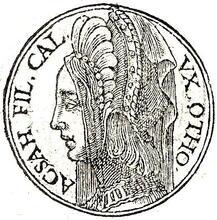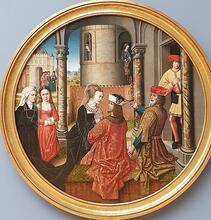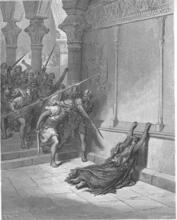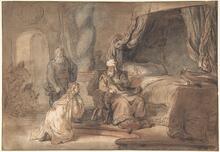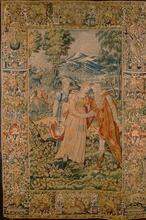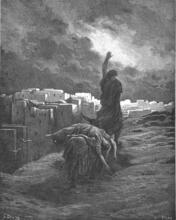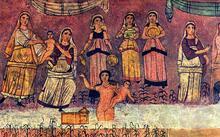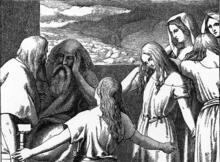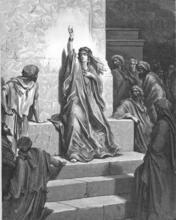Necromancer of Endor: Midrash and Aggadah
The necromancer of Endor appears in the narrative of Saul’s attempt to speak to the ghost of Samuel on the eve of war with the Philistines, although Saul initially ordered all necromancers to be removed. The necromancer knows of Saul’s ban on the use of ghosts, but Saul swears that she will be protected. The ghost of Samuel tells Saul that he would die at the hands of the Philistines, but Saul still chooses to go to battle, and therefore dies honorably. In the midrash, the Rabbis largely focus on their questions about the necromancer’s description of Samuel’s ghost.
Descriptions of the Necromancer
The Biblical narrative of the necromancer sheds light on Saul’s sorry state after the death of Samuel. This depiction of the king’s plight is amplified by the Rabbis, who determine that Saul’s consulting the necromancer was one of the reasons leading to his loss of the throne. I Chron. 10:13 asserts that Saul died “for the trespass which he had committed against the Lord.” The Rabbis list four such “trespasses” committed by Saul: the massacre in Nob, the city of priests; taking pity on the Amalekite king Agag; not heeding Samuel’s request to wait seven days for him; and communicating with the necromancer, instead of consulting the Lord (Lev. Rabbah 26:7).
According to one tradition, the necromancer was the wife of Zephaniah and the mother of Abner (Pirkei de-Rabbi Eliezer [ed. Higger], chap. 32). The Torah she-bi-khetav: Lit. "the written Torah." The Bible; the Pentateuch; Tanakh (the Pentateuch, Prophets and Hagiographia)Torah commands: “A man or a woman who has a ghost or a familiar spirit shall be put to death; they shall be pelted with stones - their bloodguilt shall be upon them” (Lev. 20:27). In this the Rabbis find an allusion to the instance of Saul: the “man” alludes to Saul and “woman” to the female necromancer. The Rabbis say that Saul should have consulted the heavenly Urim and Thummim, instead of the earthly necromancer and soothsayer, who engages ghosts and familiar spirits.
I Sam. 28:3 relates that Saul ordered the removal of the necromancers and soothsayers, but at a later time, when he was about to wage war with the Philistines, and the Lord did not answer his query regarding his success in battle, he bade his servants to find him a necromancer. The Rabbis illustrate the monarch’s inconsistency by means of a parable: a king entered a certain land, and ordered that all the roosters in the land were to be slaughtered that night. When he wanted to set forth, he asked: “Is there no cock to crow?” His servants told him: “It was you who ordered that they be slaughtered!” (Lev. Rabbah 26:7).
Saul’s Visit to the Necromancer
Saul Lieberman observes that this parable depicts the Roman custom of augury with roosters before setting out to battle. On the basis of how the roosters ate their food, the Romans divined whether they would return victorious or not (see S. Lieberman’s notes to Lev. Rabbah [ed. Margaliot], p. 878). This parable exemplified Saul’s sorry condition. He presents himself as the executor of the divine mandate to remove the necromancers and soothsayers, but immediately following this he is revealed before his servants in all his shame, when he himself consults a necromancer. The necromancer is compared to the augur’s rooster, which was one of the means employed when confronted with uncertainty of the future.
The Bible relates that Saul was disguised [va-yithapes—I Sam. 28:8] when he went to the necromancer. The A type of non-halakhic literary activitiy of the Rabbis for interpreting non-legal material according to special principles of interpretation (hermeneutical rules).midrash reads this word with the letter shin, from hofshi (free), since, by going to the necromancer, he divested himself of his kingship. The midrash then identifies the two men who went with Saul as Abner and Amasa. Interpreting the Biblical account that they came to the woman “by night,” the midrash explains that this is not to be understood literally, rather, their plight was as gloomy as night (Lev. Rabbah 26:7).
The Bible recounts that when Saul asked the woman to raise a ghost, she refused, fearing for her life; she also reiterated the fact, which was already known to him, that King Saul had banned the use of ghosts and familiar spirits in the land. In response, Saul swears by the Lord that no trouble will come to her: “As the Lord lives, you will not get in trouble over this” (I Sam. 28:10). To highlight the irony in Saul’s action, the Rabbis say that at that moment he was like a woman who is with her lover, and swears by the life of her husband. Thus, Saul comes to his forbidden lover (necromancy and soothsaying), while swearing by the husband (God). This analogy highlights the desperate situation of the king, who cannot take a clear stand regarding these forms of divination: the female necromancer is like a forbidden lover, to whom he clandestinely comes, but who is never a complete substitute for one’s legal wife.
Based on their close reading of the necromancer’s question to Saul in I Sam. 28:11: “Whom [mi] shall I bring up for you?” the Rabbis conclude that the word “mi” is a sort of code. The necromancer, so they argue, is really asking whether she should bring up for him someone from the non-Jewish nations, who ask (as does Pharaoh in Ex. 5:2): “Who [mi] is the Lord that I should heed Him”; or one from Israel, who say “Who [mi] is like You, O Lord, among the mighty” (as the Israelites declared in Ex. 15:11). In response, Saul asks her to bring up Samuel, the doyen of the prophets.
Samuel’s Ghost
When the woman performs her rites and chants her incantations, Samuel’s ghost appears. Upon seeing this apparition of the prophet, the woman is terrified: “Then the woman recognized Samuel, and she shrieked loudly, and said to Saul, ‘Why have you deceived me? You are Saul!’” (I Sam. 28:12). The Rabbis ask: How did this woman suddenly realize that the man sitting before her was Saul? They answer that when a commoner seeks to raise a ghost, the spirit rises upside down, with his head below and his feet above; but when a king requests the same thing, the spirit emerges with his head up and his feet down below. Since Samuel appeared right side up, the woman realized that the man sitting before her was none other than King Saul.
The monarch asks the woman what she sees, and she tells him: “I see a divine being [elohim] coming up from the earth” (v. 13). The Rabbis deduced from the plural “elohim” that Samuel did not emerge alone, but together with many elders (Lev. Rabbah 26:7). According to another midrashic tradition, the least plural is two, and Moses rose together with Samuel (Tanhuma [ed. Buber], Emor 4).
Yet another tradition goes so far as to claim that all the dead came up together with Samuel; when they saw Samuel materialize, they thought that the Resurrection of the Dead had come (Pirkei de-Rabbi Eliezer, [ed. Higger], chap. 32). The Rabbis ask why Saul questioned the necromancer as to Samuel’s appearance: did he not recognize the prophet when he arose? They answer that three things were said about the raising of a spirit: the one who raises him, sees the ghost but does not hear his voice; the one who needs him, hears his voice, but does not see him; and the one who does not need him, neither hears nor sees the spirit. Accordingly, the necromancer saw Samuel, but did not hear his voice, while Saul, who requested him, heard Samuel’s voice, but could not see him; and the king’s two courtiers, Abner and Amasa, did not need Samuel, and therefore neither heard his voice nor saw him.
The woman described Samuel to Saul (verse 14): “It is an old man coming up, and he is wrapped in a robe.” This robe, according to the Rabbis, was the one prepared by Hannah for her son Samuel when she brought him to the Tabernacle at Shiloh, which accompanied him his entire life: he grew up with this robe, he was buried in it and he wore it when his spirit was brought up. The Rabbis infer from this that a person will arise at the Resurrection of the Dead in the same clothing in which he was buried (Tanhuma, Emor 2).
Verse 15 states that when Samuel appeared, he asked Saul: “Why have you disturbed me and brought me up?” from which the Rabbis learned that Samuel feared that this was the Day of Judgment; and if Samuel, the doyen of the prophets, was apprehensive of this day, how much more so should other people dread the Day of Judgment. In reply to Samuel’s question, Saul states that the Lord had not answered him through other prophets or in dreams. This prompts the question by the Rabbis, why Saul did not tell him that he had also consulted the Urim and Thummim. Saul, however, did not want to mention the subject of the Urim and Thummim, for fear this would remind Samuel of the king’s sin of the massacre of the priestly city of Nob (since the Urim and Thummim were worn by the High Priest).
Samuel prophesies to the king in verse 17 that the kingship will be torn from Saul’s hands, and the Lord “has given it to your fellow, David.” The Rabbis closely compare this with Samuel’s announcement to Saul of the loss of his throne, made during the prophet’s lifetime, in which the king’s successor is not named. Now, when Saul raised Samuel’s spirit, the latter reveals to him that David is to replace him (cf. I Sam. 15:28 with 26:17). Samuel tells Saul: When I was in the world of falsehood, I feared that you would kill me, so I spoke falsely to you. Now that I am in the world of truth, I am not in awe of you, and so you hear the truth from me.
Midrashic Interpretations
One midrashic tradition learns from this episode that the words of the prophets are not to be accepted as an immutable sentence; if one does so, this is like taking a sword and stabbing oneself in the stomach with it. The midrash bases this lesson on Saul’s actions. After the king had the spirit of Samuel raised, and heard the prophet declare that he would be killed by the Philistines, he despaired of the power of prayer, and in the end fell on his sword. If he had prayed to God instead of accepting the prophesy as unchangeable, he might have been able to change the divine decree (Deut. Rabbah [ed. Lieberman], Ve’ethanan).
In another midrashic depiction, after Saul heard that he and Israel would fall into the hands of the Philistines, he asked Samuel: “Is it not possible for me to flee?” And Samuel replied: “If you flee, you will be saved.” Upon hearing this reply, Saul fell to the ground. When Abner and Amasa asked the king what had happened, he lied to them, saying: “Samuel told me that tomorrow when I go forth to battle I shall be victorious, and my sons shall become princes.” Then God summoned the ministering angels and told them: “Come and see the being that I have created in my world. In the way of the world, when a person goes to a bet ha-mishteh [the tavern of antiquity], he does not take his sons with him, for appearance’s sake. But this one, Saul, goes forth to war, knowing that he will be killed, yet he takes his sons with him, and rejoices at the divine justice that strikes him” (Lev. Rabbah 26:7). In a different midrashic account, Samuel tells Saul: “If you heed my counsel, it would be worthwhile for you to fall on your sword. Thus your death will atone for you, and you shall be together with me.” Saul took the prophet’s advice, and fell on his sword, together with all his sons (Pirkei de-Rabbi Eliezer [ed. Higger], chap. 32).
These two traditions explain why, after hearing Samuel’s bleak prediction of the battle’s outcome, Saul nevertheless went forth to fight the Philistines. Saul is portrayed as dying a heroic death, by his acceptance of the divine verdict, as was fitting for the first king of Israel (Lev. Rabbah 26:7; Tanhuma Buber, Emor 4; Pirkei de-Rabbi Eliezer, [ed. Higger] chap. 32).

